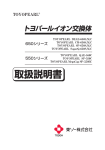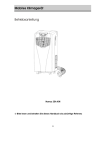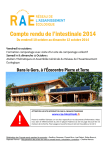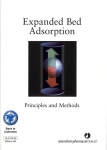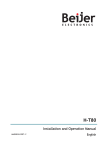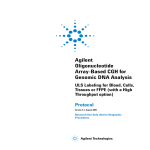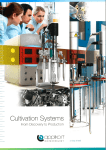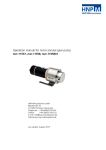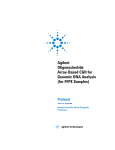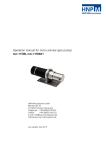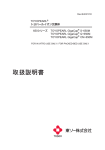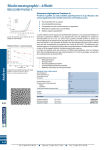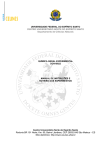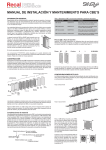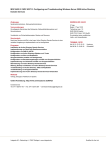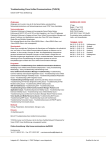Download Toyopearl Instruction Manual
Transcript
TOSOH BIOSCIENCE ToYoPeaRL insTRUcTion manUaL Tosoh bioscience Zettachring 6, 70567 Stuttgart, Germany Tel: +49 (0)711 13257 0 Fax: +49 (0)711 13257 89 [email protected] www.tosohbioscience.com 100% from well-managed forests www.fsc.org Zert.-Nr. IMO-COC-028664 ® IMO-COC-028664 1996 Forest Stewardship Council TOSOH BIOSCIENCE TOSOH BIOSCIENCE M09p18a 1 Tosoh bioscience gmbh Zettachring 6 70567 Stuttgart Germany t · + 49 (0) 711 · 13257 - 0 f · + 49 (0) 711 · 13257 - 89 [email protected] www.tosohbioscience.com 2 Tosoh bioscience LLc 156 keystone drive montgomeryville, pa 18936 - 9637, USA t · +1 215-283-5000 f · +1 215-283-5035 [email protected] www.tosohbioscience.com 3 Tosoh corporation 3-8-2 Shiba, Minato-Ku TOKYO 105-8623 japan t · +81 3-5427-5180 f · +81 3-5427-5220 [email protected] www.tosohbioscience.com 4 Tosoh SHANGHAI CO. LTD ROOM 2618A, INTERN. TRADE CENTER, NO. 2201 YAN-AN WEST ROAD SHANGHAI, 200336 CHINA Tosoh bioscience PROCESS t ·+86 21-6270-2810 f · +86 21-6270-2820 [email protected] www.tosohbioscience.com To get an overview about the whole range of our: bulk media for biopurification, please request our process catalog columns and small bulk media, please request our chromatography catalog 1 2 3 4 TOSOH HISTORY 1935 Founding of Toyo Soda Manufacturing Co., Ltd. 1936 Operation of Nanyo Manufacturing Complex begInS 1971 Scientific Instruments Division formed, First GPC column using TSK-GEL developed by Tosoh 1974High performance liquid chromatography column plant Is completed 1979 Tosoh develops TOYOPEARL media 1983 Tosoh develops Hydrophobic Interaction Media 1987 TosoHaas US operations formed in Montgomeryville 1989 TosoHaas GmbH operations formed in Stuttgart 1995 Tosoh Nanyo gel facility receives ISO 9001 2000In November former TosoHaas US operations becOmeS TOSOH BIOSEP LLC, a 100% subsidiary of Tosoh Corporation 2001In January former TosoHaas GmbH European Operations becOmeS TOSOH BIOSEP GmbH, a 100% subsidiary of Tosoh Corporation 2002/ Tosoh Corporation announces that all Tosoh affiliated scientific and diagnostic system 2003 related companies in Europe, will be unified under the new name TOSOH BIOSCIENCE. 2008 ECOSEC , THE 7TH GENERATION GPC SYSTEM IS INTRODUCED GLOBALLY 2009 20th anniversary of tosoh bioscience gmbh, stuttgart For a deeper insight into applications and all questions related to the practical use of TSK-GEL and Toyopearl check our website www.tosohbioscience.com and the related catalogues or instruction manuals. Our technical experts are happy to discuss your specific separation needs via hotline: +49 (0) 1805 012299 or mail: [email protected] PRocess 1 Toyopearl® instruction Manual Table of Contents I. Packing 2 1. PreparationforPacking 1.1 GeneralConsiderationforPacking 1.2 RemovalofFines 1.3 BufferEquilibration 1.4 SlurryPreparation 1.5 AlternativeSlurryPreparation 2 2 2 3 3 4 2. PackingProcedure 2.1 ConstantVelocity/ Semi-constantPressureMethod 2.2 AlternativePackingMethod,AssistedGravity 5 6 8 3. EquilibrationandEfficiencyEvaluation II. ColumnOperation 9 10 1. ChromatographicSeparation 1.1 SizeExclusion(SEC) 1.2 IonExchange(IEC) 1.3 HydrophobicInteraction(HIC) 1.4 Affinity(AFC) 10 10 10 10 11 2. Cleaning 11 3. Storage 12 4. Sterilization/Depyrogenation/ PreservativeRemoval/ColumnFrits 13 III.ToyopearlProductOverview 14 IV.ProcessColumnInstallations 15 ToYoPeARL Tosoh bioscience ToYoPeARL 2 www.Tosohbioscience.coM TOSOH BIOSCIENCE PAcKinG introduction FIGuRE2 Toyopearlbaseparticle Toyopearl chromatographic resins are macroporous polymeric packings for bioprocess chromatography. They are applicable for the laboratory and process scale purifications of globular proteins, peptides, nucleic acids, and other biologically derived materials. These resins are a modified methacrylate polymer which gives the resin a hydrophilic surface due to the presence of ether and hydroxyl groups. It also confers upon the resin excellent pressure/flow characteristics and pH stability. i. Packing 1. Preparation for Packing 1.1 General considerations for Packing Toyopearl It is best to pack Toyopearl resins by the application of pressure from 0.5 to 3 bar (7 to 45 psi) across the bed length. Although it is not recommended, Toyopearl resins can be packed by simple gravitational settling. The equipment components (shown in Fig. 1) required to successfully pack Toyopearl resins are: a pump, a pressure gauge, a level, glasses, acrylic or PEEK or stainless steel column and a packing reservoir (optional). FIGuRE1 Equipmentrequiredforpacking 1.2 Removal of Fines Tosoh Bioscience recommends that fines be removed. Fines in the gel slurry may obstruct screens or sintered filters and may eventually increase the pressure drop across the column. The following decantation process is required to remove fines from the resin slurry. a) The settled resin in the shipping containers should be suspended by vigorous agitation or stirring with a rod or paddle (do not use a magnetic stirrer; it will grind the resin, generating fines). Once suspended, transfer the required amount of suspension (approximately 4 volumes suspension = 3 volumes resin) into a container of sufficient volume to hold 4 times the volume of resin being prepared. Add distilled water or buffer to 4 times the resin volume and stir thoroughly. example for Fine Removal: 5 liter resin ordered = 7 - 8 liter of suspension in total (65 - 70 % slurry concentration) Fill in a 20 liter vessel and fill up with 12 liter water. b) Allow the resin to settle. Settling time is dependent on the vessel height, the slurry concentration, the solvent, and the resin particle size. The average settling times for Toyopearl resins in water in a typical measurement cylinder are: Toyopearl PoreSize Minutes Coarse(“C”)Grade 100µm 15-30 Medium(“M”)Grade 65µm 30-45 Fine(“F”)Grade 45µm 45-60 Superfine(“S”)Grade 35µm 60-90 Tosoh bioscience PRocess 3 ToYoPeARL PAcKinG In larger tanks sedimentation of particles takes longer: 50%slurry 65µmparticlesneed 3-4hourspermeterSD inwater 35µmparticlesneed 5-7hourspermeterSD 65µmparticlesneed 3-5hourspermeterSD in1MNaCl 35µmparticlesneed 12-16hourspermeterSD in1.8M 65µmparticlesneed (NH4)2SO4 6-9hourspermeterSD in20% 65µmparticlesneed ethanol 6hourspermeterSD TABLE1 Typicalpackingbuffer 25%slurry 65µmparticlesneed 1,5-2,5hourspermeterSD 35umparticlesneed 2-3,5hourspermeter 65µmparticlesneed 2-3hourspermeterSD 35µmparticlesneed 3-7hourspermeterSD 65µmparticlesneed 4-8hourspermeterSD SEC HW-40,HW-50,HW-55,HW-65 andHW-75 0.1MNa SO ,NaNO ,orNaClin 50mMphosphateorTrisbuffer 2 4 3 IEC DEAE-type,QAE,Q-type,CM-type, 1MNaClin50mMphosphate, SP-type,MegaCapII-SP Tris,oracetatebuffer HIC Ether-650,Phenyl-type,Butyl-type, Hexyl-650,PPG-600, 2MNa SO ,(NH ) SO orNaClin 50mMphosphatebuffer 2 4 4 2 4 AFC AF-TresylandAF-Epoxy-650 SD=SedimentationDistance c) Once the resin has settled, carefully decant the supernatant. 0.5MNaClin0.1MNaHCO or phosphatebuffer AF-Formyl-650,AF-Amino-650,and 1MNaClin100mMphosphate AF-Carboxy-650,ProteinA orNaHCO buffer AF-Chelate-650,AF-BlueHC-650 0.5MNaClor0.2Mglycinein andAF-Red-650 20mMphosphateorTrisbuffer 3 3 FIGuRE3+4 Decant Re-suspend 1.4 slurry Preparation After de-fining the resin, the slurry concentration can be adjusted for packing the column. The slurry concentration is calculated as the volume of settled gel divided by the total volume of the slurry, and the slurry concentration is adjusted as follows: d) Add three times the resin volume of either distilled water or packing buffer to the decantation vessel, and re-suspend the resin by gentle overhead stirring. Do not use a magnetic stir bar; it will grind the resin, generating fines. e) Repeat steps c) and d) at least two more times. 1.3 buffer equilibration When choosing a packing buffer, it is best to choose empirically since the optimal buffer will vary with your specific application. In general, the highest ionic strength mobile phase to be used in the separation (including the cleaning and sanitization steps) is a suitable starting point. Some typical packing buffers are listed in Table 1. a) Resuspend the resin slurry in the de-fining vessel and transfer the homogeneous slurry to a graduated cylinder b) Allow the slurry to settle overnight (>12 hours) for best results. c) Determine the settled resin volume, and adjust the slurry concentration to 30 - 50 % by adding or removing packing buffer. d) For packing a column of a given volume, use the following amounts of settled resin: HW-40,HW-50,HW-55, HW-65,andHW-75F useapproximately 1.1xthecolumn volume Ether-650,Phenyl-type,Butyl-type, Hexyl-650,PPG-600,DEAE-type,Q-type, CM-650,SP-type,GigaCap-typeandall affinity useapproximately 1.2xthecolumn volume QAE-550CandSP-550C ToyopearlMegaCapIISP550EC useapproximately 1.25xthecolumn volume ToYoPeARL 4 www.Tosohbioscience.coM TOSOH BIOSCIENCE PAcKinG 1.5 Alternative slurry Preparation a) Re-suspend the resin slurry in the de-fining vessel and transfer the homogeneous slurry to a Büchner funnel or equivalent. b) Filter the slurry under suction until the slurry becomes a wetcake (all excess liquid has been removed). c) Weigh out the appropriate amount of resin wetcake (1 g of wetcake ≈ 1 ml of gravity settled gel) using the above table. d) Transfer the wetcake to a beaker and add enough packing buffer to make a slurry concentration of 30 - 50 %. FIGuRE5 Settledresininwater Tosoh bioscience PRocess 5 ToYoPeARL PAcKinG 2. Packing Procedures DonotpackToyopearlliketraditionalsoftgels.ForbestresultsToyopearlshouldbepackedatahigherflowrateandpressure! TABLE2 PackingandoperatingvelocitiesforToyopearlresins LABORATORYSCALE ResinType ColumnSize Grade (cmIDxcmL) SEC IEC* AFC* Operatingvelocity flowrate(cm/hr) (cm/hr) (ml/min) HW-40 2.2x60 S(30µm) F(45µm) C(75µm) 30-40 60-80 120-160 10–25 25–50 50–100 0.6-1.6 1.6-3.2 3.2-6.4 HW-50 2.2x60 S(30µm) F(45µm) 25-35 50-70 10–20 25–35 0.6-1.3 1.6-2.2 HW-55 2.2x60 S(30µm) F(45µm) 25-35 50-70 10–20 25–35 0.6-1.3 1.6-2.2 HW-65 2.2x60 S(30µm) F(45µm) 20-75 40-150 10–15 15–30 0.6-1.0 1.0-1.9 HW-75 2.2x60 F(45µm) 40-150 15–30 1.0-1.9 DEAE-650,SuperQ-650 CM-650,SP-650 GigaCapS,CM,Q 2.2x20 S(35µm) M(65µm) C(100µm) 400-600 800-1000 800-1200 45-65 80-130 80-600 3.0-4.0 5.0-8.0 5.0-40 SP-550 QAE-550 2.2x20 C(100µm) 700-1000 80-240 5.0–15 EC(100-300µm) 800-1200 80-500 5.0-30.0 2.2x20 S(35µm) M(65µm) C(100µm) 400-600 800-1000 800-1200 700-1000 45-65 80-130 80-500 80-240 3.0-4.0 5.0-8.0 5.0-30 5.0–15 2.2x10 M(65µm) 800-1000 30-130 2.0-8.0 ToyopearlMegaCapIISP-550 HIC* Packingvelocity Ether-650,Hexyl-650,Butyl-600, Phenyl-650,PPG-600,Butyl650,SuperButyl-550,PPG-600, Phenyl-600 AF-Amino-650,AF-Tresyl-650 AF-Carboxy-650,AF-Blue-650 AF-Formyl-650,AF-Chelate-650 AF-Epoxy-650,AF-Blue-650 * Not all resins are available in all particle sizes. PROCESSSCALE Thepackingvelocityinprocessscalecolumnsshouldbeatleast1.5xtheoperatingvelocity Please call our product specialists for your individual discussion. ToYoPeARL 6 www.Tosohbioscience.coM TOSOH BIOSCIENCE PAcKinG The following descriptions are valid for packing under flow. If you have other equipment, or pack greater than 5 liters, please call our Technical Specialists. We have experience with many different column designs and brands. d) Carefully pour the resin slurry slowly down along the inside wall of the column. Prevent air from being trapped in the resin slurry. e) After the resin slurry is transferred to the column, rinse the inside walls of the column using a squirt bottle containing packing buffer. TABLE3 Featuresofpackingmethods Packing Method Constant Pressure Constant Velocity Assisted Gravity fast fast slow FlowRateRange uptohigh uptohigh limitedtolow Pump constant pressure constant velocity peristalticpump PressureGauge needed needed notneeded Packing Velocity b) Ensure that the column is leveled prior to packing. Wet the bottom frit or screen in the column with buffer. Allow the buffer to drain a few seconds to remove any air bubbles. Plug the outlet of the column and leave 1 - 2 cm of buffer in the bottom of the column. FIGuRE6 Pouringtheresin 2.1 constant Velocity / semi-constant Pressure Methods a) If used, place the packing reservoir on the column. The total volume of the column and the reservoir should be sufficient to allow the entire resin slurry to be poured in one operation. FIGuRE8 f) Immediately place the flow adapter of the column onto the resin slurry. There should be no trapped air between the flow adapter and the buffer. g) Open the column outlet, and start the pump. Start slowly to flow packing buffer through the column. FIGuRE9 Adjustingcolumn Bubblefree,liquidcoveredbottomfrit c) Resuspend the resin slurry to assure homogeneity. FIGuRE7 Homogeniseslurry h) Two different Packing Methods can be applied: constant Velocity Method Slowly increase to the final flow rate. This prevents hydraulic shock to the forming bed and prevents uneven packing of the column bed. The flow rate can be ramped up in several incremental changes. These increments will be determined by the size of the column and target flow rate. Some examples are listed in Table 4. Tosoh bioscience PRocess 7 ToYoPeARL PAcKinG Pressure Method Slowly ramp up to the target pressure. This prevents hydraulic shock to the forming bed, and therefore prevents uneven packing of the column. The pressure can be maintained by manually decreasing the flow rate to keep a constant pressure on the forming bed. The optimal packing pressure for Toyopearl resins is around 3 bar (44 psi) across the bed length. TABLE4 FIGuRE11 Flowadapterinplace Typicalpackingbuffer ColumnSize (IDxL) MediaType TargetFlow Rate(ml/min) 2.2cmx60cm HW-55S 2 9cmx30cm QAE-550C 25cmx30cm DEAE-650M Increment HoldTime (ml/min) (min) 0.5 0.5 300 50 2 2,000 400 3 i) After the bed has fully formed, shut off the pump, and close the column outlet. FIGuRE10 Clearsupernatantofsedimentingresin m) The bed will compress further. When compression is complete and pressure is stable, stop the pump and close the column outlet. n) Carefully loosen the flow adapter seal and lower the adapter near to the resin bed. Take care not to disturb the resin bed when moving the flow adapter. FIGuRE12+13 Bubblefree (recommendable) Airdisturbshomogenious settlingprocedure j) The entire bed should reside in the lower column section if using a packing reservoir. Using a pipette or pump, siphon the supernatant from the upper reservoir. Remove the upper reservoir and the coupling ring. k) Carefully place the flow adapter into the column, approximately 2 - 3 cm away from the consolidated bed. Avoid introduction of air into the column. l) Secure the flow adapter in place, begin the pump as described in step h (Pressure Method), and open the column outlet. o) Repeat steps l) - n), until there is no further compression of the resin bed from the flow adapter (< 0.5 cm). It will usually take 2-3 iterations until the bed is stable. p) In the final step lower the adapter 1 - 5 mm into the bed. q) The column is now ready for efficiency evaluation. (see page 8) ToYoPeARL 8 www.Tosohbioscience.coM TOSOH BIOSCIENCE PAcKinG 2.2 Alternative Packing Method, Assisted Gravity Due to hardware constraints, it may not be possible to use a reservoir when packing Toyopearl resin. The following method was developed to pack the resin without a packing reservoir. FIGuRE14 Assistedcravitypackingmethod a) Adjust the resin slurry concentration to 50 %, and gently resuspend the resin with overhead stirring. Do not use a magnetic stirrer! b) As shown in Figure 14, attach a peristaltic pump to the bottom outlet of the column. c) Ensure that the column is leveled prior to packing. d) With the pump running in the upflow direction, backflow packing buffer into the column until it is about 50 % full. Stop the pump. e) With the pump running at the desired flow rate in the downflow direction, slowly add the homogeneous resin slurry to the column. Pour the slurry down along the inner wall of the column to prevent the formation of air bubbles. f) When the bed is almost entirely formed, and with approximately 2-3 cm of buffer above the bed, shut off the pump and column outlet valve. g) Gently rinse down the inside walls of the column with a squirt bottle containing packing buffer. h) Carefully place the flow adapter into the column, with the adapter just touching the packing buffer. l) After bed consolidation is complete, stop the pump and shut the bottom outlet. i) With the adapter firmly in place, place the pump in front of the column. Eliminate air in tubing. m) Loosen the seal on the flow adapter, and gently place the flow adapter onto the resin bed. Be careful not to allow resin past the column seal. j) Start the pump at a low flow rate; open the bottom valve. k) Slowly ramp up to the target flow rate. This prevents hydraulic shock to the forming bed, and therefore prevents uneven packing of the column. The flow rate can be ramped up in several ml/minute increments over the initial phase of the packing. The size and duration of these increments will be determined by the size of the column which is being packed (see Table 4). n) Repeat steps l) through m) until there is no further bed compression from the flow adapter (< 0.5 cm). o) In the final step lower the adapter 1 - 5 mm into the bed. p) The column is now ready for an efficiency evaluation. (see page 9) Tosoh bioscience PRocess 9 ToYoPeARL PAcKinG 3. equilibration and efficiency evaluation Once the packing operation is completed, equilibrate the column with 5 - 10 column volumes of low ionic strength buffer. Test the effectiveness of the packing procedure by injecting a sample (0.25 - 1% of the column volume) of a low molecular weight, unretained compound (i.e. acetone, Vitamin B12, sodium chloride), and determine the column plate count and asymmetry as shown in Figure 15. Columns packed according to the above procedures, and operated at linear velocities of 50 – 250 cm/h (depending on the particle size) should have the minimum plate counts listed in Table 5, and asymmetries between 0.8 - 1.5 when tested. Efficiency Ve Platespercolumn(N)=5.54(Ve/W1/ )2 2 h SEC IEC HIC AFC /2 W1 =widthofpeakathalfheight(h) /2 /2h 1 Injection Asymmetry Ve TABLE5 Column ID(cm) W1 Ve=elutionvolumeatthepeakmaximum Asymmetry(As)=b/a Typicalpackingbuffer Mode FIGuRE15 Howtocalculateefficiency&asymmetryFactor h Asismeasuredat10%ofthepeakheight(h). SGrade FGrade MGrade (plates/M) (plates/M) (plates/M) CGrade (plates/M) 2.2 5.5 10.8 21.0 31.0 40.0 5,000 5,000 5,000 4,000 - 3,500 3,300 2,500 2,200 2,000 1,800 - 3,000 1,500 1,200 1,000 2.2 5.5 10.8 21.0 31.0 40.0 6,000 6,000 6,000 4,000 - - 4,000 4,000 4,000 2,600 2,000 1,500 2,000 2,000 1,000 750 2.2 5.5 10.8 21.0 31.0 40.0 6,000 6,000 6,000 4,000 - - 4,000 4,000 4,000 2,600 2,000 1,500 2,000 2,000 1,000 750 2.2 5.5 10.8 21.0 31.0 40.0 - - 4,000 4,000 4,000 2,600 2,000 1,500 - Ifthereisalargedeviationfromexpectedplateheightnumberand assymetryfactors,pleaserepeatthepackingprocedure. Ifcolumndiameters>40cmareutilized,thenumberofplates/Mcan slightlydecrease ForfurtherdetailscallourTechnicalSpecialists. a b /10h 1 Injection TABLE6 Troubleshootingperformanceevaluation AS<0.8 AS>1.4 Overpackingthecolumn. Packingattoohighpressure. Columnbedcracking. Columnnotpacked“tight” enough.Cloggedscreensorfrits attoporbottomofthecolumn. Smallvoidattopofcolumn.Air pocketsincolumnhardwarevoid spaces.Poorinjectiontechnique. HighHETP* LowHETP* Probemoleculeretainedon Injectionsampleordetectortoo farfromcolumn.Injectionvolume columnduetointeractionwith functionalgrouporbackbone. toohigh.Columnnotpacked efficiently. *HETP(HeightEquivalenceofaTheoreticalPlate) ToYoPeARL 10 www.Tosohbioscience.coM TOSOH BIOSCIENCE coLUMn oPeRATion ii. column operation ExamplesforbuffersusedinIEC 1. chromatographic separation 1.1 size exclusion chromatography (sec) Equilibrate the resin with 5 - 10 column volumes of an appropriate buffer solution (see Table 1). Size exclusion separations on Toyopearl HW columns are performed under isocratic conditions using buffered salt solutions of moderate ionic strength. Sample volumes are usually 1 - 3% of the column packed bed volume. If retention times are shorter or longer than expected, changes in the mobile phase may be necessary. Please refer to Table 7 for suggested mobile phase changes. TABLE7 NonidealSECbehavior Observation Cause/Solution Retention time is shorter than expected Samplecanbepartiallyortotally excluded from column, confirm MW of sample and use a resin with higher exclusion limit if necessary. Anionic molecules can be repulsed by ionic exclusion, increasetheionicstrengthofthe mobilephase. Retention time is longer than expected TABLE8 Cationic molecules can be retarded by ionic attraction, increasetheionicstrengthofthe mobilephase. Hydrophobic molecules can be retarded by hydrophobic attraction, decrease the ionic strength of the mobile phase or addasmallpercentage(10-20%) of an organic solvent such as methanol,ethanol,oracetonitrile. 1.2 ion exchange chromatography (iec) Equilibrate the column with 5 to 10 column volumes of an appropriate starting buffer solution (Table 8 ). The elution is performed by increasing the salt concentration or changing the pH of the eluent. If the ion-exchanger fails to adsorb the desired protein, change the pH of the equilibration buffer to enhance the electrostatic interaction between the protein and the ion-exchanger, or decrease the salt concentration in the equilibration buffer. ResinType Buffer BufferingRange Cation Exchangers Aceticacid Citricacid MES Phosphate HEPES 4.8-5.2 4.2-5.2 5.5-6.7 6.7-7.6 7.6-8.2 Anion Exchangers L-Histidine Imidazole Triethanolamine Tris-HCl Diethanolamine 5.5-6.0 6.6-7.1 7.3-7.7 7.5-8.0 8.4-8.8 1.3 hydrophobic interaction chromatography (hic) Equilibrate the column with an appropriate buffer solution containing a concentrated (generally 1 M to 3 M) neutral salt such as one listed in Table 9. High ionic strength enhances the hydrophobic interaction between proteins and the resin and thus facilitates adsorption. Before introducing a sample onto the column, make at least one blank analysis and equilibrate the column in the initial mobile phase. Elute adsorbed proteins by decreasing the concentration of salt in the eluent. Proteins with lower hydrophobicity are eluted earlier and at higher salt concentrations than more hydrophobic proteins. If the desired protein is not eluted by this method, add a small percentage of organic solvent or nonionic detergent, change the eluent pH, or lower the temperature. See Table 10 for suggestions on what organic solvents, detergents, or chaotropes to use. If sample profiles are inconsistent, first increase the column equilibration step by using an additional 3 to 10 column volumes of starting eluent. If the desired protein is not adsorbed on the column, increase the concentration of salt in the starting buffer or adjust the pH of the buffer closer to the isoelectric point of the protein. TABLE9 NeutralsaltsusedinHIC Salt(listed in decreasing order of strength)* Comments SodiumCitrate MayexhibithighuVabsorbency, pronetomicrobialgrowth AmmoniumSulfate NotstableabovepH8,lowuV interference,resistsmicrobial growth,mostcommonlyused saltforHIC SodiumSulfate Solubilityislow(1.5Mat25°C) SodiumChloride Halidesaltcanbecorrosiveto stainlesssteel,inexpensive PotassiumChloride Halidesaltcanbecorrosiveto stainlesssteel * - based on the Hofmeister series of lyotropic salts Tosoh bioscience PRocess 11 ToYoPeARL coLUMn oPeRATion TABLE10 MobilephaseadditivesforHIC EluentsforexhaustiveelutionfromAFToyopearlresins OrganicAdditives Detergents ChaotropicAgents ethanol methanol isopropanol n-butanol acetonitrile ethyleneglycol guanidinehydrochloride tetraethylammoniumchloride urea potassiumthiocyanate TritonX-100 octylglucoside Tween20 SDS CHAPS Emulgen911 CTAB LubrolPX TABLE11 1.4 Affinity chromatography (AFc) Included among the Toyopearl affinity resins are both group specific ligand resins (Chelate, Red and Blue-HC), and resins with surface chemistries that allow attachment of custom ligands by the end user. Contact Tosoh Bioscience Technical Service for information concerning coupling chemistries for the attachment of ligands to Formyl, Carboxy, Amino, Epoxy and Tresyl Toyopearl. equilibration AF Red, AF Blue-HC and Chelate resins should be equilibrated with 3 - 5 column volumes of the appropriate starting buffer, such as phosphate or Tris, with little or no salt. The dye affinity chromatographic resins may release a small amount of conjugated dye during storage. Be sure to wash the dye affinity columns before each use to remove the released dye. Wash a column containing new resin with 1 M sodium chloride or 1 M potassium chloride. Use 2 M potassium chloride or 4 M urea for washing used resin. Equilibrate a column containing old or new resin with an appropriate starting buffer, such as 20 mM phosphate at pH 7.5. Loading and elution After applying the sample, wash the column with 3 - 5 column volumes of starting buffer to remove unadsorbed impurities. Two kinds of elution methods are commonly used in affinity chromatography: nonspecific and specific. Choice: Choice: 2MKClor3MNaCl 1%TritonX-100/1MNaSCN/ 75%ethyleneglycol/4Murea or0.1MNaOH/4.2M(NH4)2SO4 2. cleaning Toyopearl resins can be cleaned in the column or removed from the column and treated in bulk. The cleaning method and duration of treatment depend on the extent of contamination. At least three bed volumes of cleaning solution are typically employed in column washing procedures. sec Resins In most cases, the resins can be cleaned simply by washing with distilled water to desorb remaining proteins. For more tenaciously bound materials, the following solutions may be required: ionically-bound materials For moderately bound materials, 0.5 - 1 M aqueous salt solutions can be used to clean the resin. For more strongly bound materials, 0.1 - 0.5 M sodium hydroxide or 0.1 - 0.5 M hydrochloric or sulfuric acid is appropriate. Under no circumstances should nitric acid be used to clean Toyopearl resins! Nitric acid can react violently with Toyopearl resins. Because acids sometimes cause protein aggregation, first use an alkaline solution for removing proteins. hydrophobically-bound materials About 10 - 20 % of an alcohol such as ethanol, methanol, or isopropanol can be used to remove hydrophobic materials. Solvents such as acetonitrile and acetone can also be used. It is important to remember that solvents can sometimes cause protein aggregation. After using any base, acid, or organic solvent, use distilled water as a final rinse. Nonspecific elution generally is achieved by increasing the salt concentration in the eluent. Most proteins are eluted with a solution containing 2 M sodium chloride or 3 M potassium chloride. Proteins not eluted with these eluents can be eluted with solutions listed in Table 11. iec Resins For moderate contamination, wash with 0.5 - 1 M sodium chloride, then equilibrate with the starting buffer. For severe contamination, wash with 0.1 - 0.5 M sodium hydroxide, then with 0.1 - 0.5 M sodium chloride, then equilibrate with the starting buffer. In specific elution, an enzyme is eluted with a solution containing its substrate or coenzyme. A substrate or coenzyme concentration below 10 mM usually is sufficient for elution. For extremely severe contamination of DEAE and QAE resins, wash with 0.1 - 0.5 M sodium hydroxide, then distilled water, then 0.1 - 0.5 M hydrochloric acid, and then 0.1 - 0.5 M sodium chloride. Equilibrate with the starting buffer. A high salt mobile phase can be used as a final rinse to assure the correct counter ion is present. ToYoPeARL 12 www.Tosohbioscience.coM TOSOH BIOSCIENCE coLUMn oPeRATion hic Resins In most cases, the resins can be cleaned simply by washing with distilled water to desorb remaining proteins. For more tenaciously bound materials, the following solutions may be required: ionically-bound materials For moderately bound materials, 0.5 - 1 M aqueous salt solutions can be used to clean the resin. For more strongly bound materials, 0.1 - 0.5 M sodium hydroxide or an appropriate acid such as hydrochloric or sulfuric is appropriate. Under no circumstances should nitric acid be used to clean Toyopearl resins! Because acids sometimes cause protein aggregation, first use an alkaline solution for removing proteins. hydrophobically-bound materials 10 - 40% of an alcohol such as ethanol, methanol, or isopropanol can be used to remove hydrophobic materials. Solvents such as acetonitrile and acetone can also be used. It is important to remember that solvents can sometimes cause protein aggregation. Non-ionic detergents may also be used for cleaning. After using any base, acid, or organic solvent, use distilled water as a final rinse. AFc Resins High concentrations of neutral salts, chaotropes, or detergents such as those listed in Table 9 should be used as eluents prior to extensive cleaning efforts. Remaining protein contaminants adsorbed on the resin can be removed by washing with two column volumes of 0.5 M sodium hydroxide followed by distilled water. Sodium hydroxide should be used with AF-Heparin and AF-Protein only in cases of extreme contamination. 3. storage sec, iec, and hic Store the column or used bulk resin in distilled water containing a bacteriostatic agent, such as 20% ethanol, preferably at 4°C to 25°C. AFc Store the column or used bulk resin in a neutral solution of 1 M sodium chloride or potassium chloride containing a bacteriostatic agent, such as 20% ethanol, preferably at 4°C to 10°C. For AF-Formyl 650M, store the column or used bulk resin in a neutral solution of 1 M sodium chloride or potassium chloride in 1% gluteraldehyde, preferably at 4°C to 10°C. Please note that dye affinity chromatographic resins may release a small amount of dye during storage. Be sure to wash the dye affinity resin before each use to remove any released dye. Tosoh bioscience PRocess 13 4. sterilization / Depyrogenation / Preservative Removal / column Frits sterilization Toyopearl resins can be sterilized by autoclaving at 121°C for 20 min. without altering their properties. Alternatively, columns already packed may be exposed to 200 ppm sodium hypochlorite for periods up to 12 hours without loss of function. Depyrogenation Toyopearl resins are recommended for use from pH 2 to 12. However, short exposures (< 12 hours) to higher pH (0.5 N NaOH) are acceptable for depyrogenation. Typically endotoxin levels are reduced by at least 4 logs following a 4-hour treatment with 0.5 N NaOH followed by a wash with 3 column volumes of endotoxin-free equilibration buffer. ToYoPeARL coLUMn oPeRATion Preservative Removal Shipping solvents for Toyopearl resins contain 20% ethanol (with exception of some affinity products). The resin preparation procedures outlined in this document will reduce the ethanol level in the packed column effluent. column Frits Pressure-related problems are often caused by clogged column frits. Remove the frits and clean thoroughly as recommended by the column manufacturer. If the problem persists, replace the frits. ToYoPeARL 14 www.Tosohbioscience.coM TOSOH BIOSCIENCE ToYoPeARL PRoDUcT oVeRView IEC Toyopearl Resin Anion-exchangers SuperQ-650 (S, M, C), QAE-550C, DEAE-650 (S, M, C), GigaCap Q-650M (M=75 µm) Q-600C AR Pore size 400 500 1.000 1.000 750 Å Å Å Å Å s = 35 µm, M = 65 µm, c = 100 µm cation-exchangers CM-650 (S, M, C), SP-650 (S, M, C), SP-550C, MegaCap II SP-550EC, GigaCap S-650M, (50-100 µm) GigaCap CM-650M, (50-100 µm) 1.000 1.000 500 500 1.000 1.000 Å Å Å Å Å Å HIC Ether-650 (S, M), PPG-600M , Phenyl-600M, Phenyl-650 (S, M, C), Butyl-650 (S, M, C), Butyl-600M, SuperButyl-550C, Hexyl-650C, s = 35 µm, M = 65 µm, c = 100 µm Toyopearl Resin Pore size Toyopearl Reactive Resins AF-Amino-650M, AF-Carboxy-650M, AF-Formyl-650M, 1.000 Å 1.000 Å 1.000 Å Toyopearl Activated Resins AF-Epoxy-650M, AF-Tresyl-650M, 1.000 Å 1.000 Å Toyopearl Ready to use Resins AF-BlueHC-650M, AF-Chelate-650M, AF-HeparinHC-650M, AF-Red-650ML, 1.000 1.000 1.000 1.000 Toyopearl Resin Å Å Å Å M= 65 µm, ML =65 µm s = 35 µm, M = 65 µm, c = 100 µm, ec= 200 µm AFC SEC Pore size Toyopearl Resin Pore size 1.000 750 750 1.000 1.000 750 500 1.000 HW-40 (S, F, C), HW-50 (S, F), HW-55 (S, F), HW-65 (S, F, C), HW-75 (F), 50 Å 125 Å 500 Å 1.000 Å > 1.000 Å Å Å Å Å Å Å Å Å s = 30 µm, F = 45 µm, c = 75 µm Tosoh bioscience PRocess 15 Column Manufacturer BioRad Column Type InPlace/Geltec GEHealthcare Lifesciences AxiChrom variousbeddimensions (IDxLincm) 20-45x15-25 130x24 60x20 ToYoPeARL PRocess coLUMn insTALLATions ColumnPerformances Af platecount[N/m] ResinType 0,8-1,4 1,1-1,2 3.000-4.000(60cm/h-salt) 3.500-3.900(300cm/h-salt) HIC-65µm IEC-65µm 1,1 8.000(100cm/h-salt) HIC-65µm BPG 20-30x11-25 0,9-1,3 4.000-11.000(40cm/h-salt) IEC/HIC-65µm Chromaflow 40-80x15-24 1,1-1,4 3.000-5.000(100cm/h-salt) IEC-65µm Index 20-35x28-32 20x15-25 1,3-1,4 0,8-1,6 14.-20.000(20cm/h-acetone) 3.000-6.000(100cm/h-acetone) IEC-20µm IEC/HIC-35/65µm Merck Superformance 20-30x15-30 20x30 1,0-1,3 1,2 2.500-3.500(100cm/h-acetone) 7.000(250cm/h-acetone) IEC-65µm IEC-20µm Millipore IsoPak/Access 44x25 44x13-30 100-160x15-25 140x25 160x13-15 200x30 1,2-1,5 1,1-1,4 1,2-1,4 1,4-1,7 1,0 1,2-1,4 6.000-9.000(acetone-60cm/h) 3.000-8.000(130-20cm/h) 4.000-6.000(salt-60cm/h) 5.000-7.000(salt-60cm/h) 600-900(acetone-100cm/h) 4.000-5.500(100cm/h-salt) IEC-35µm IEC/HIC-65µm IEC/HIC-65µm IEC-35µm IEC-100µm HIC-65µm QuikScale 20-30x13-20 14-30x13-33 63x17 1,2-1,6 1,3-1,6 1,2-1,4 4.000-10.000(acetone-100cm/h) 2.500-5.000(acetone-100cm/h) 2.500-4.000(acetone-130cm/h) HIC-35µm IEC -65µm IEC-65µm Moduline 140x20-25 0,8 5.000-6.000(salt-30cm/h) IEC-65µm Pall/Euroflow ResoluteTM 40-80x12-32 40-80x14-32 40-100x21-28 100-140x20-25 1,1 0,8-1,2 1,0-1,2 1,0-1,3 16.000-19.000(salt-60cm/h) 3.000-7.000(salt-30cm/h) 1.000-3.000(salt-100cm/h) 3.000-7.000(salt-80cm/h) HIC-35µm HIC/IEC-65µm IEC-100/200µm HIC-65µm PeakBiotech/ DANProcess LPLC-DAC 30x19-21 30x20 30x20 1,3-1,4 1,2-1,8 1,2 13.000-17.000(salt-100cm/h) 6.000-8.000(salt-100cm/h) 4.000(salt-80cm/h) HIC/IEC-20µm HIC/IEC-35µm IEC-65µm Proxcys CRIO-radialflow 1,0-1,2 3.000-7.000(salt-100cm/h) IEC-65µm 5-20literBV,6-11,6cmL These examples show real values for any packing condition given. it need not to be the achievable optimum. we have more than 10 years of experience in packing production columns of various manufacturers. Please call our specialist for your individual discussion. in addition we assist you on-site. ToYoPeARL 16 TOSOH BIOSCIENCE YoUR noTes www.Tosohbioscience.coM 1 Tosoh bioscience gmbh Zettachring 6 70567 Stuttgart Germany t · + 49 (0) 711 · 13257 - 0 f · + 49 (0) 711 · 13257 - 89 [email protected] www.tosohbioscience.com 2 Tosoh bioscience LLc 156 keystone drive montgomeryville, pa 18936 - 9637, USA t · +1 215-283-5000 f · +1 215-283-5035 [email protected] www.tosohbioscience.com 3 Tosoh corporation 3-8-2 Shiba, Minato-Ku TOKYO 105-8623 japan t · +81 3-5427-5180 f · +81 3-5427-5220 [email protected] www.tosohbioscience.com 4 Tosoh SHANGHAI CO. LTD ROOM 2618A, INTERN. TRADE CENTER, NO. 2201 YAN-AN WEST ROAD SHANGHAI, 200336 CHINA Tosoh bioscience PROCESS t ·+86 21-6270-2810 f · +86 21-6270-2820 [email protected] www.tosohbioscience.com To get an overview about the whole range of our: bulk media for biopurification, please request our process catalog columns and small bulk media, please request our chromatography catalog 1 2 3 4 TOSOH HISTORY 1935 Founding of Toyo Soda Manufacturing Co., Ltd. 1936 Operation of Nanyo Manufacturing Complex begInS 1971 Scientific Instruments Division formed, First GPC column using TSK-GEL developed by Tosoh 1974High performance liquid chromatography column plant Is completed 1979 Tosoh develops TOYOPEARL media 1983 Tosoh develops Hydrophobic Interaction Media 1987 TosoHaas US operations formed in Montgomeryville 1989 TosoHaas GmbH operations formed in Stuttgart 1995 Tosoh Nanyo gel facility receives ISO 9001 2000In November former TosoHaas US operations becOmeS TOSOH BIOSEP LLC, a 100% subsidiary of Tosoh Corporation 2001In January former TosoHaas GmbH European Operations becOmeS TOSOH BIOSEP GmbH, a 100% subsidiary of Tosoh Corporation 2002/ Tosoh Corporation announces that all Tosoh affiliated scientific and diagnostic system 2003 related companies in Europe, will be unified under the new name TOSOH BIOSCIENCE. 2008 ECOSEC , THE 7TH GENERATION GPC SYSTEM IS INTRODUCED GLOBALLY 2009 20th anniversary of tosoh bioscience gmbh, stuttgart For a deeper insight into applications and all questions related to the practical use of TSK-GEL and Toyopearl check our website www.tosohbioscience.com and the related catalogues or instruction manuals. Our technical experts are happy to discuss your specific separation needs via hotline: +49 (0) 1805 012299 or mail: [email protected] TOSOH BIOSCIENCE ToYoPeaRL insTRUcTion manUaL Tosoh bioscience Zettachring 6, 70567 Stuttgart, Germany Tel: +49 (0)711 13257 0 Fax: +49 (0)711 13257 89 [email protected] www.tosohbioscience.com 100% from well-managed forests www.fsc.org Zert.-Nr. IMO-COC-028664 ® IMO-COC-028664 1996 Forest Stewardship Council TOSOH BIOSCIENCE TOSOH BIOSCIENCE M09p18a






















